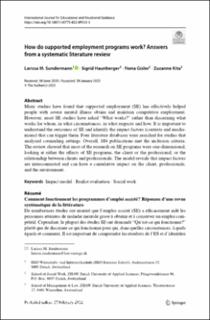Please use this identifier to cite or link to this item:
https://doi.org/10.21256/zhaw-24527| Publication type: | Article in scientific journal |
| Type of review: | Peer review (publication) |
| Title: | How do supported employment programs work? : answers from a systematic literature review |
| Authors: | Sundermann, Larissa M. Haunberger, Sigrid Gisler, Fiona Kita, Zuzanna |
| et. al: | No |
| DOI: | 10.1007/s10775-022-09533-3 10.21256/zhaw-24527 |
| Published in: | International Journal for Educational and Vocational Guidance |
| Volume(Issue): | 23 |
| Issue: | 3 |
| Page(s): | 659 |
| Pages to: | 679 |
| Issue Date: | 2022 |
| Publisher / Ed. Institution: | Springer |
| ISSN: | 1573-1782 1873-0388 |
| Language: | English |
| Subjects: | Impact model; Realist evaluation; Social work |
| Subject (DDC): | 361: Social work and welfare |
| Abstract: | Many studies have found that supported employment (SE) has efectively helped people with severe mental illness obtain and maintain competitive employment. However, most SE studies have asked “What works?” rather than discerning what works for whom, in what circumstances, in what respects and how. It is important to understand the outcomes of SE and identify the impact factors (contexts and mechanisms) that can trigger them. Four literature databases were searched for studies that analyzed counseling settings. Overall, 104 publications met the inclusion criteria. The review showed that most of the research on SE programs were one-dimensional, looking at either the efects of SE programs, the client or the professional, or the relationship between clients and professionals. The model reveals that impact factors are interconnected and can have a cumulative impact on the client, professionals, and the environment. |
| Further description: | Erworben im Rahmen der Schweizer Nationallizenzen (http://www.nationallizenzen.ch) |
| URI: | https://digitalcollection.zhaw.ch/handle/11475/24527 |
| Fulltext version: | Published version |
| License (according to publishing contract): | CC BY 4.0: Attribution 4.0 International |
| Departement: | Social Work |
| Organisational Unit: | Institute of Management and Social Policy (ISM) |
| Published as part of the ZHAW project: | Wirkfaktoren professionellen Handelns in sozialen Organisationen (WIFASO) |
| Appears in collections: | Publikationen Soziale Arbeit |
Files in This Item:
| File | Description | Size | Format | |
|---|---|---|---|---|
| 2022_Sundermann-etal_Supported-employment-programs-literature-review.pdf | 1.22 MB | Adobe PDF |  View/Open |
Show full item record
Sundermann, L. M., Haunberger, S., Gisler, F., & Kita, Z. (2022). How do supported employment programs work? : answers from a systematic literature review. International Journal for Educational and Vocational Guidance, 23(3), 659–679. https://doi.org/10.1007/s10775-022-09533-3
Sundermann, L.M. et al. (2022) ‘How do supported employment programs work? : answers from a systematic literature review’, International Journal for Educational and Vocational Guidance, 23(3), pp. 659–679. Available at: https://doi.org/10.1007/s10775-022-09533-3.
L. M. Sundermann, S. Haunberger, F. Gisler, and Z. Kita, “How do supported employment programs work? : answers from a systematic literature review,” International Journal for Educational and Vocational Guidance, vol. 23, no. 3, pp. 659–679, 2022, doi: 10.1007/s10775-022-09533-3.
SUNDERMANN, Larissa M., Sigrid HAUNBERGER, Fiona GISLER und Zuzanna KITA, 2022. How do supported employment programs work? : answers from a systematic literature review. International Journal for Educational and Vocational Guidance. 2022. Bd. 23, Nr. 3, S. 659–679. DOI 10.1007/s10775-022-09533-3
Sundermann, Larissa M., Sigrid Haunberger, Fiona Gisler, and Zuzanna Kita. 2022. “How Do Supported Employment Programs Work? : Answers from a Systematic Literature Review.” International Journal for Educational and Vocational Guidance 23 (3): 659–79. https://doi.org/10.1007/s10775-022-09533-3.
Sundermann, Larissa M., et al. “How Do Supported Employment Programs Work? : Answers from a Systematic Literature Review.” International Journal for Educational and Vocational Guidance, vol. 23, no. 3, 2022, pp. 659–79, https://doi.org/10.1007/s10775-022-09533-3.
Items in DSpace are protected by copyright, with all rights reserved, unless otherwise indicated.